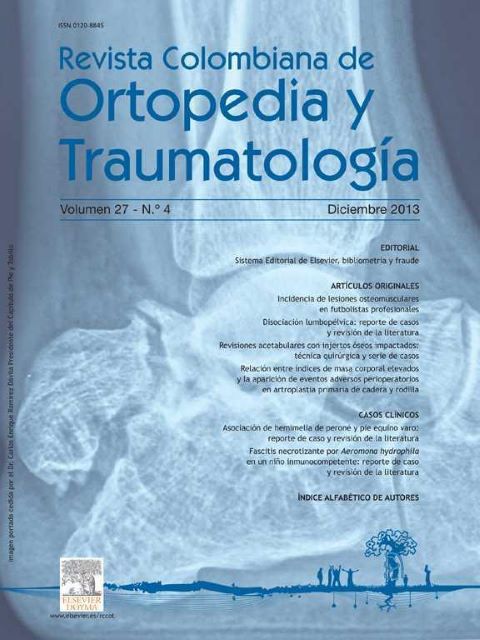Relationship between high body mass index and adverse events in primary hip and knee arthroplasties
DOI:
https://doi.org/10.1016/S0120-8845(13)70021-XKeywords:
arthroplasty, replacement, hip/adverse effects, arthroplasty, replacement, knee/adverse effects, body mass index, obesity/complications, evidence level: ivAbstract
Background: One of the current goals in total hip and knee surgery is to control perioperative adverse events. An important step to achieve this goal is the identification of the factors that increase the risk of occurrence for those outcomes. The aim of this study was to identify the relationship between an increased body mass index (BMI) and the risk of perioperative adverse events in total hip or knee arthroplasty.
Methods: A retrospective study was conducted by identifying patients who underwent total hip or knee replacement and determining the association between body mass index and the frequency of adverse events. Descriptive statistical analysis was subsequently performed and correlation coefficients were calculated.
Results: A total of 194 hip or knee arthroplasties were reviewed, which included 73 patients with a normal BMI and 121 patients with an increased BMI. An adverse event was recorded in 12.5% of the patients in the normal BMI group, whereas 8.4% and 10.5% in the overweight and obesity groups, respectively, had adverse events. In the category of serious adverse events, the rates were 4.2%, 2.4%, and 0%, respectively.
Discussion: In this study, an increased body mass index was not related to a higher prevalence of perioperative adverse events. There does not seem to be an increased risk for complications in overweight patients who undergo a total hip or knee arthroplasty.
Downloads
References
Nwachukwu B, Collins J, Nelson E, Concepcion M, Thornhill T, Katz J. Obesity & hypertension are determinants of poor hemodynamic control during total joint arthroplasty: a retrospective review. BMC Musculoskelet Disord. 2013;14:20. https://doi.org/10.1186/1471-2474-14-20
Huddleston JI, Wang Y, Uquillas C, Herndon JH, Maloney WJ. Age and obesity are risk factors for adverse events after total hip arthroplasty. Clin Orthop Relat Res. 2012;470:490-6. https://doi.org/10.1007/s11999-011-1967-y
Haverkamp D, Klinkenbijl MN, Somford MP, Albers GH, van der Vis HM. Obesity in total hip arthroplasty-does it really matter? A meta-analysis. Acta Orthop. 2011;82:417-22. https://doi.org/10.3109/17453674.2011.588859
Davis AM, Wood AM, Keenan AC, Brenkel IJ, Ballantyne JA. Does body mass index affect clinical outcome post-operatively and at five years after primary unilateral total hip replacement performed for osteoarthritis? A multivariate analysis of prospective data. J Bone Joint Surg Br. 2011;93:1178-82. https://doi.org/10.1302/0301-620X.93B9.26873
Foran JR, Mont MA, Etienne G, Jones LC, Hungerford DS. The outcome of total knee arthroplasty in obese patients. J Bone Joint Surg Am. 2004;86-A:1609-15. https://doi.org/10.2106/00004623-200408000-00002
Lozano LM, Núñez M, Segur JM, Maculé F, Sastre S, Núñez E, et al. Relationship between knee anthropometry and surgical time in total knee arthroplasty in severely and morbidly obese patients: a new prognostic index of surgical difficulty. Obes Surg. 2008;18:1149-53. https://doi.org/10.1007/s11695-008-9481-3
Michalka PK, Khan RJ, Scaddan MC, Haebich S, Chirodian N, Wimhurst JA. The inà uence of obesity on early outcomes in primary hip arthroplasty. J Arthroplasty. 2012;27:391-6. https://doi.org/10.1016/j.arth.2011.05.012
Yeung E, Jackson M, Sexton S, Walter W, Zicat B, Walter W. The effect of obesity on the outcome of hip and knee arthroplasty. Int Orthop. 2011;35:929-34. https://doi.org/10.1007/s00264-010-1051-3
Andrew JG, Palan J, Kurup HV, Gibson P, Murray DW, Beard DJ. Obesity in total hip replacement. J Bone Joint Surg Br. 2008; 90:424-9. https://doi.org/10.1302/0301-620X.90B4.20522
Kessler S, Käfer W. Overweight and obesity: two predictors for worse early outcome in total hip replacement? Obesity (Silver Spring). 2007;15:2840-5. https://doi.org/10.1038/oby.2007.337
Miric A, Lim M, Kahn B, Rozenthal T, Bombick D, Sculco TP. Perioperative morbidity following total knee arthroplasty among obese patients. J Knee Surg. 2002;15:77-83.
Felson DT, Naimark A, Anderson J, Kazis L, Castelli W, Meenan RF. The prevalence of knee osteoarthritis in the elderly. The Framingham Osteoarthritis Study. Arthritis Rheum. 1987;30:914-8. https://doi.org/10.1002/art.1780300811
Gillespie GN, Porteous AJ. Obesity and knee arthroplasty. Knee. 2007;14:81-6. https://doi.org/10.1016/j.knee.2006.11.004
Downloads
Published
How to Cite
Issue
Section
License
Copyright (c) 2024 Revista Colombiana de ortopedia y traumatología

This work is licensed under a Creative Commons Attribution 3.0 Unported License.




